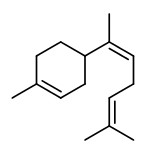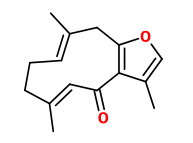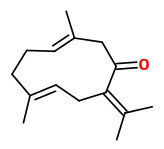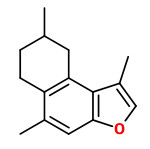Commiphora erythraea (Ehrenb.) Engl. - Burseraceae - agarsu, bisabol myrrh, opopanax, Bisabol-Myrrhe, Bisabol-Opopanax,
Small tree, native to Somalia.
The term 'opopanax' traditionally refers to the medicinal gum resin from plants of the genus Opopanax like Opopanax chironium (L.) W.D.J.Koch (Hercules' all-heal; syn. Ferula opopanax Spreng.; Pastinaca opopanax L.) used in herbal medicine rather than perfumery. To distinguish bisabol myrrh resin 'opopanax' from the true opopanax, it is often alternatively spelled opoponax, and sometimes referred to as the opopanax of perfumery or perfumery's opopanax. Opopanax (perfumery)
„A number of oleo-gum-resins called bdelliums are produced in Arabia and Somalia from various species of
Commiphora and resemble myrrh; these were probably counted as myrrh in classical times and are probably used for adulteration today. The 'perfumed bdellium' (opopanax or bisabol myrrh) is from C. erythraea…
C.erythraea and C. kataf, the main sources of opopanax, are abundant in many parts of southern Arabia, Somalia, eastern Ethiopia and Kenya.“
Opopanax resin oil has been found to contain α-bisabolene, β-bisabolene, and γ-bisabolene, α-bergamotene, γ-cadinene, δ-cadinene, ar-curcumene and α-santalene, but the results are not consistent. (Z)-α-bisabolene remotely recalls the typical odour of opopanax.
[Myrrh-commiphora chemistry., Hanuš, L.O., Řezanka, T., Dembitsky, V.M., Moussaieff, A., Biomedical papers, 149(1), 2005, 3-28; and literature cited therein] http://jonnsaromatherapy.com/pdf/GC-MS_Commiphora_various_2005.pdf
„Opoponax odour is sweetly aromatic, with a tenacious animalic, woody root-like note, not found in Myrrh.“ Main components of Opoponax oil were E-β-ocimene (26.2%), α-santalene (20.1%), E α-bergamotene (5.2%), and (Z/E)-α-bisabolene (14.2%).
[Moyler, D. A., R. A. Clery, and K. A. D. Swift. „Flavours and Fragrances.“ Special Publications No. 214 (1997): 96-115]
„Opopanax oil and opopanax resinoid are obtained from the resin of Commiphora erythraea Engl. var. glabrescens Engl., a tree growing in Somalia (Burseraceae). The resinoid is prepared by solvent extraction, and steam distillation of the resin gives the essential oil, which is a yellow to greenish-yellow liquid with a warm, sweet, balsamic odor… Opopanax oil and resinoid are used in perfume compositions with oriental characteristics, the resinoid also for its fixative properties.“
[H. Surburg und J. Panten: Common Fragrance and Flavor Materials: preparation, properties, and uses. Wiley-VCH, Weinheim 2006, 221]
 (Z)-α-bisabolene (balsamic, opopanax) |  1(10),4-furanodien-6-one |  germacrone (faint sweet-woody herbaceous) |  dihydropyrocurzerenone (resinous, myrrh-like) |
The resin essential oil of C. erythraea obtained by steam distillation contained two furanosesquiterpenoids as dominant constituents, 1(10),4-furanodien-6-one (21.5%), and 1,10(15)-furanogermacradien-6-one (14.3%), together with rel-3R-methoxy-4S-furanogermacra-1E,10(15)-dien-6-one (7.4%) and rel-2R-methoxy-4R-furanogermacra-1(10)E-en-6-one (3.9%). Minor components were eg. aromadendrene (4.4%), α-gurjunene (3.8%), α-copaene (3.4%), as well as curzerenone (1.5%), germacrone (0.9%), and dihydropyrocurzerenone (0.8%). „In our oil, we could not identify either ocimene, although this was the most abundant monoterpene of the opopanax oil studied by Ikeda, or α- and β-bisabolenes.“
[Chemical composition of the essential oil of Commiphora erythraea., Marcotullio, M.C., Santi, C., Mwankie, G., Curini, M., Natural product communications, 4(12), 2009, 1751-4]
„In all the oils and extracts, furanodienone [1(10),4-furanogermacradien-6-one] resulted the most abundant compound along with 1,10(15)-furanogermacra-dien-6-one, 3-methoxy-furanogermacra-1E,10(15)-dien-6-one, 2- methoxy-furanogermacra-1(10)E-en-6-one, 1,2-epoxy- furanogermacr-10(15)-en-6-one, dihydropyrocurzerenone, agarsenone, myrrhone, curzerenone, furanoeudesma-1,4-dien-6-one and alismol. Agarsenone showed to be unstable in chlorinated solvents, giving rise in short time, to mirrhone, and, by autoxidation, to agarsenolides…“
[Marcotullio, Maria Carla, Ornelio Rosati, and Daniela Lanari. „Phytochemistry of Commiphora erythraea: A Review.“ Natural Product Communications 13.9 (2018): 1934578×1801300925]
https://journals.sagepub.com/doi/pdf/10.1177/1934578X1801300925
The hexane extract of Commiphora erythraea (Ehrenb.) Engl. resin showed topical anti-inflammatory, free radical scavenging, antifungal activities and antioxidant activities. Bioguided separation of the extract led to furanosesquiterpenoids as active constituents.
[Anti-inflammatory, antioxidant and antifungal furanosesquiterpenoids isolated from Commiphora erythraea (Ehrenb.) Engl. resin., Fraternale, D., Sosa, S., Ricci, D., Genovese, S., Messina, F., Tomasini, S., Marcotullio, M.C., Fitoterapia, 82(4), 2011, 654-661]
„Furanodienone and 1,10(15)-furanogermacra-dien-6-ones showed to be potent inhibitors of lipid peroxidation (IC 50 of ~0.087 μM), being more active than the methoxylated analogues. Furthermore, using BV2 microglial cells, we found that furanodienone from C. erythraea is able to counteract LPS-induced cell death and decrease LPS-induced NO generation thus protecting microglial cells from LPS-induced cytotoxicity.“
[Protective effects of Commiphora erythraea resin constituents against cellular oxidative damage., Marcotullio, M.C., Messina, F., Curini, M., Macchiarulo, A., Cellanetti, M., Ricci, D., Bellezza, I., Molecules, 16(12), 2011, 10357-10369]
The vitro anti-inflammatory activity of 1(10),4-furanodien-6-one was shown by exposing microglial BV-2 cells to lipopolysaccharide. Pre-treatement with this furanodien-6-one restored cell viability and ROS to control levels while halving NO generation; production of pro-inflammatory IL-6, IL-23, IL-17, TGF-β, and INF-γ, significantly induced by LPS, was also markedly reduced. 1(10),4-furanodien-6-one protected primary neuronal cultures against the inflammatory/toxic insults of LPS-treated BV-2 conditioned media, indicating anti-inflammatory/cytoprotective effects in neuronal cells. In adult mice ip-injected with LPS, 1(10),4-furanodien-6-one had strong cerebral anti-inflammatory properties by inhibiting liver and brain TNFα as well as IL-1β expression. The results provide strong evidence that 1(10),4-furanodien-6-one could be exploited to counteract degenerative pathologies based on neuroinflammation.
[Furanodien-6-one from Commiphora erythraea inhibits the NF-κB signalling and attenuates LPS-induced inflammation., Bellezza, I., Mierla, A., Grottelli, S., Marcotullio, M. C., Messina, F., Roscini, L., … & Minelli, A., Molecular immunology, 54(3), 2013, 347-354]